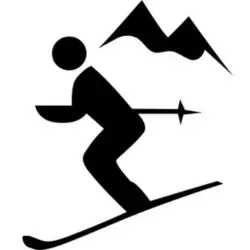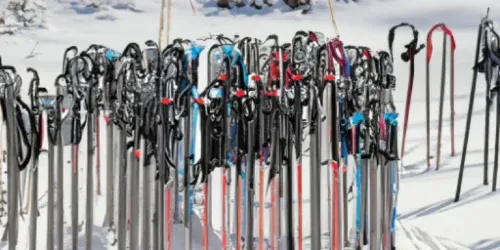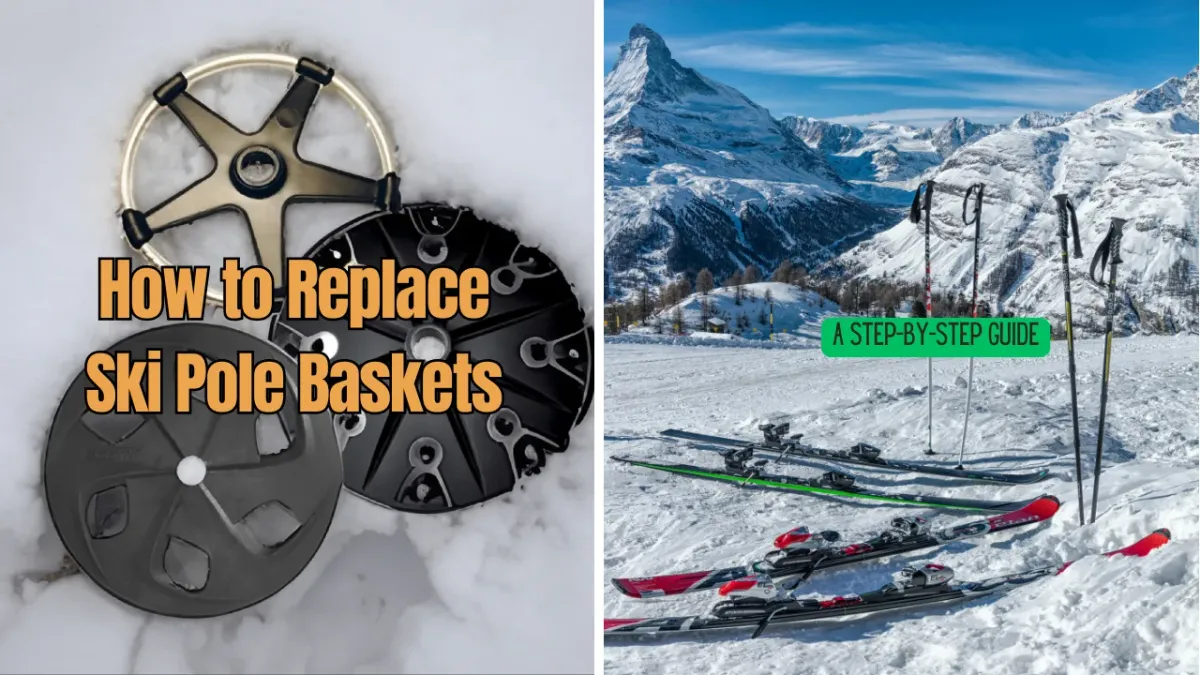When it comes to outdoor adventures, having the right gear is crucial for both safety and enjoyment. Hiking enthusiasts often debate whether ski poles can double as hiking sticks. This article delves into the practicality and considerations of using ski poles for hiking.
Key Takeaways:
- Ski poles can be repurposed as hiking sticks, but there are specific factors to consider such as pole length and terrain.
- Using ski poles for hiking can provide benefits like improved balance and reduced strain on the knees, especially on steep inclines.
- It's important to choose poles with the right features, such as a carbide tip and adjustable length, to ensure they are suitable for hiking.

The Basics of Hiking Sticks and Ski Poles
Hiking sticks, also known as trekking poles, are designed to provide stability and support on uneven ground. They come in various styles, with features tailored to the needs of hikers. Ski poles, on the other hand, are intended for backcountry skiing and nordic walking, offering balance and propulsion on snowy terrain. While most poles for skiing are fixed in length, many hiking sticks offer adjustable lengths to cater to different heights and terrain types.

Pole Length: A Critical Factor
Pole length is one of the most crucial aspects to consider when using ski poles for hiking. For nordic walking, poles are typically shorter to match the user's height and walking posture. However, for hiking, especially on steep terrain, adjustable poles that can be lengthened for descents and shortened for ascents are ideal. This adaptability is something that most ski poles lack, which could limit their effectiveness as hiking sticks.
Benefits of Using Two Poles
Many hikers prefer using two poles for the symmetry and balance they provide. Two poles can help distribute the effort across the upper body, reducing fatigue and strain on the legs. This is particularly beneficial on steep inclines or when carrying a heavy backpack. Additionally, two poles can aid in maintaining a consistent rhythm and pace, which can be advantageous for long-distance hikers or thru-hikers.
Single Pole Versus Two Poles
While two poles offer greater stability, some hikers opt for a single pole, especially for less challenging trails or when needing a free hand for tasks like map reading or river crossing. A single pole can still offer support and balance but may not provide the same level of upper body engagement as using two poles.
The Role of the Carbide Tip
The carbide tip is a feature found on most poles, designed to grip various surfaces and provide traction. When using ski poles for hiking, the carbide tip becomes essential, especially on rocky or slippery terrain. It helps prevent the pole from slipping and ensures a secure plant with each step.

Adjustability: A Must for Hiking
Adjustability in pole length is a significant advantage when transitioning from flat ground to steep terrain. Most poles designed for hiking have this feature, allowing hikers to shorten or lengthen the poles as needed. Ski poles, typically non-adjustable, may not offer the same versatility, which is one reason they may not be ideal for all hiking situations.
Durability and Material Considerations
When considering whether to use a ski pole as a hiking stick, it's essential to examine the durability and materials involved. Ski poles are typically designed to withstand the cold and impact of winter sports, often made from aluminum or carbon fiber. These materials offer a balance between lightweight design and strength, which is crucial when facing a steep incline or navigating rocky terrain. However, the materials used in ski poles may not always provide the flexibility needed for the varied and unpredictable conditions encountered by thru-hikers.
In contrast, hiking sticks are specifically crafted to endure the rigors of the trail. They are often made from robust materials like aluminum, carbon, or even wood, and are designed to absorb shock more effectively. This is particularly important when descending steep inclines, where the pressure on the poles is greatest. For thru-hikers embarking on long-distance treks, a hiking stick made from materials that can withstand constant use and changing weather conditions is indispensable. While a ski pole can serve as a makeshift hiking stick, dedicated hikers may prefer the reliability of a purpose-built hiking stick.
Customization and Accessory Options
Customization is another aspect to consider when choosing between a ski pole and a hiking stick. Ski poles are generally straightforward in design, with limited options for personalization. They come with a standard grip and a fixed basket size, which is ideal for snow but may not be as functional on a muddy trail or during a river crossing. Thru-hikers often seek poles that can be tailored to their specific needs, including the ability to change out baskets or tips depending on the terrain.
Hiking sticks, on the other hand, offer a range of accessory options that can enhance the hiking experience. Interchangeable tips, for example, allow hikers to switch between carbide tips for rocky paths and rubber tips for paved surfaces. Some hiking sticks also come with various basket sizes to prevent sinking into soft ground or snow. For thru-hikers who encounter diverse environments, the ability to customize their hiking stick to the specific challenges of the trail is a significant advantage. This level of customization ensures that whether facing a steep incline or crossing a fast-flowing stream, the hiking stick is optimized for safety and performance.
The Importance of Upper Body Engagement
Hiking with poles engages the upper body, providing a full-body workout. This can be particularly beneficial for those looking to improve their fitness level or for nordic walking enthusiasts who are accustomed to the upper body workout that comes with using poles. Ski poles can offer similar benefits if used correctly.
Handling Steep Inclines with Poles
On steep inclines, poles can be a hiker's best friend. They help in distributing the body's weight and provide additional points of contact with the ground, which can prevent falls and reduce the impact on knees and ankles. Ski poles with the right length can be used effectively on steep terrain, but adjustable hiking sticks are generally more suitable.

River Crossings and Pole Use
When facing a river crossing, poles can offer the stability needed to navigate slippery rocks and strong currents. A sturdy pole with a good grip, like those with a carbide tip, can be invaluable in such situations. Ski poles can serve this purpose, but their fixed length may not be optimal for all river crossing scenarios.
Backcountry Skiing Versus Hiking Demands
Backcountry skiing and hiking have different demands, and the design of poles reflects this. Ski poles are created to withstand the forces of skiing and are often not as flexible as hiking sticks. However, for casual hikes or those familiar with the rigidity of ski poles, they can be a suitable alternative.
Thru-Hikers and Pole Preferences
Thru-hikers, who embark on long-distance trails, often have strong preferences for their gear. While most poles used by thru-hikers are specifically designed for hiking, some may choose to use ski poles for their durability and the familiarity of use during winter treks.
Choosing the Right Pole for Your Adventure
Ultimately, the decision to use ski poles for hiking comes down to personal preference and the specific requirements of the hike. Factors such as terrain, distance, and individual comfort with the gear should all be considered. For those accustomed to nordic walking or backcountry skiing, using ski poles for hiking might feel natural.

Summary
Ski poles can be repurposed for hiking, but it's essential to consider factors like pole length, terrain, and the need for adjustability. While ski poles may not offer all the features of dedicated hiking sticks, they can provide benefits such as improved balance and reduced strain on the body. Choosing the right pole for your hiking adventure is a personal decision that should be made based on the specific needs of your journey.

FAQs
Can I use my ski poles for hiking on any terrain?
Ski poles can be used for hiking on various terrains, but they may not be as effective on steep or uneven ground due to their fixed length. Adjustable hiking poles are generally better suited for diverse terrains.
Are ski poles as durable as hiking sticks for long-distance treks?
Ski poles are designed to withstand the rigors of skiing and can be quite durable. However, hiking sticks are specifically made to handle the constant impact of trekking, so they may be more durable for long-distance hiking.
Should I use one or two ski poles for hiking?
Using two poles can provide better balance and distribute the workload across your upper body, which is beneficial on challenging trails or for long distances. However, for light hikes or when you need a free hand, a single pole may suffice.
Related Articles:











